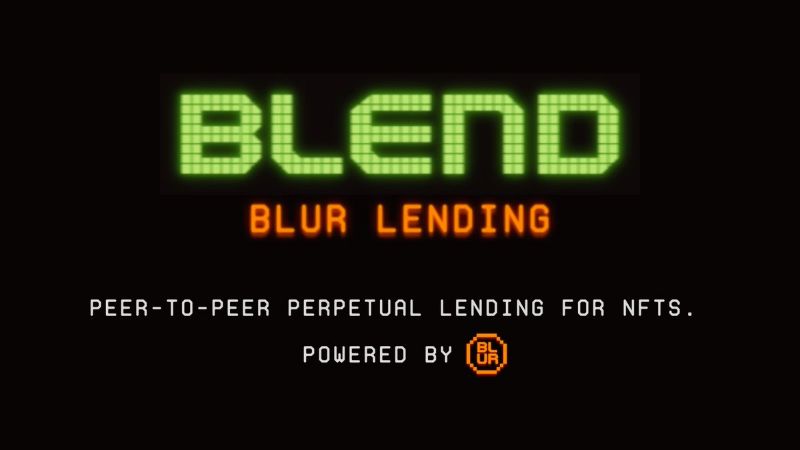
Built in collaboration with @danrobinson and @transmissions11 at @paradigm, Blend enables 10x higher yield opportunities than current DeFi protocols and unlocks greater liquidity for NFTs.
Here’s how 👇 https://t.co/uOFC6i3LSq – @blur_io (twitter)
On May 1, NFT marketplace Blur officially unveiled its new service called Blend, short for Blur lending. The release was met with mixed reception, with some praising the move while others are concerned about the potential dangers.
Blend is a new transactional protocol that allows users without enough money to buy blue-chip NFTs in advance. The buyer would only be required to list their NFT asset as collateral, and they can pay the rest afterward, just like in traditional lending systems.
Blend works as a peer-to-peer, perpetual lending system that accepts NFT collateral. The team behind Blend claims that it charges no transaction fee to lenders and borrowers.
1/ Introducing Blend: the Peer-to-Peer Perpetual Lending Protocol for NFTs.
Built in collaboration with @danrobinson and @transmissions11 at @paradigm, Blend enables 10x higher yield opportunities than current DeFi protocols and unlocks greater liquidity for NFTs.
Here’s how 👇 pic.twitter.com/uOFC6i3LSq
— Blur (@blur_io) May 1, 2023
Blur explained on Twitter that “borrowers still pay interest on loans based on what lenders offer,” and 100 percent of the interest goes to the lender.
Blur’s new platform was a collaboration product with venture capital firm Paradigm. It will allow traders to maximize NFT liquidity by allowing token purchasers to provide collateral.
The platform’s developers say that Blend will allow buyers who were previously unable to afford expensive collections like CryptoPunk NFTs and Bored Ape Yacht Club to purchase the assets.
Similar to homebuyers making a down payment and then paying the mortgage later, collectors can apply the same principles to NFT markets by putting up a percentage of the total NFT price and financing the remaining balance.
The NFT marketplace wars pic.twitter.com/8p4Npc5UIQ
— Udi Wertheimer 🧙♂️ (@udiWertheimer) February 25, 2023
Talks surrounding NFT-lending
According to Binance, NFT lending provides several benefits for NFT owners, including increased liquidity, access to upfront capital and the ability to diversify their portfolios.
Since NFTs can be less liquid than other digital assets, lending them out can provide quicker access to fiat or crypto liquidity. Owners can also obtain capital for purchasing limited-edition NFTs without giving up ownership of their favorite collectibles.
NFT lending services like Blend can also be useful for risk management and diversification by spreading investments across various assets.
1st rule for #NFTs : only invest money you can afford to lose. If you need a loan, you’re overexposed! So just don’t do it and don’t let blur tell you something else! In this space there are kids playing with money. Giving them a loan and take their poket money is just criminal https://t.co/N3IqSWLTbL
— Taki_Nooby_Booby (@Taki_NoobyBooby) May 1, 2023
While some view Blend as a welcome addition, others have the opposing sentiment, even going so far as calling out the United States Securities and Exchange Commission (SEC) to take action and protect users from such products.
One community member shared their thoughts on Twitter, saying the move is “massive for the space.” Another also weighed in on the matter, saying that “it provides a distraction from overall negative sentiment.”
Massive for the space – great move by @blur_io. Effectively this allows you to loan out your ETH for yield, and also allows better cash/jpeg efficiency. https://t.co/PikWKqN0Jn
— peepeedog.eth (@peepeedog) May 2, 2023
The user could refer to the declining number of NFT buyers in April. During this month, sellers dominated the market, according to the analytics site NFTGo.
Even though some community members believe Blend could bring in new opportunities, others are rightfully concerned about the possibility of defaulting on the loan and losing more money.
Another member shared their valid concern regarding the risk, saying that people should “only invest money [they] can afford to lose.”
I’m not a fan of lending.
Now people can pay minimum amount for blue chip NFT, with the risk that not being able to pay it off quickly and losing much more money.
I don’t know, I’m a little scared about it https://t.co/q6fTqnkKEd
— kyle (@IsKyleETH) May 2, 2023
Attorney Jesse Hynes has even tagged the SEC to protect investors from such conduct, calling the NFT lending system “extremely dangerous.”
The community also said the release of Blend could start an “NFT marketplace war” between Blur and OpenSea.
The NFT market has become more competitive, with companies like OpenSea and Blend vying for dominance. OpenSea has already taken steps to maintain its position, including eliminating fees and introducing a marketplace aggregator.
In response, Blend plans to launch its own NFT marketplace, which will feature $300 million worth of BLUR tokens. Despite mixed reactions from the community, Blend’s entry into the market could potentially boost liquidity in the struggling NFT market.
